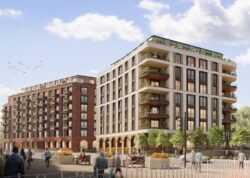 Abraham Lincoln
If given the truth, the people can be depended upon to meet any national crisis...
Abraham Lincoln
If given the truth, the people can be depended upon to meet any national crisis...
 Guildford news...
for Guildford people, brought to you by Guildford reporters - Guildford's own news service
Guildford news...
for Guildford people, brought to you by Guildford reporters - Guildford's own news service
Letter: Planning Committee Should Reconsider Debenhams Proposal
Published on: 22 Nov, 2022
Updated on: 22 Nov, 2022
In response to: The Debenhams Decision Will Leave a 100-year Legacy
I have over forty years’ experience of designing buildings in this country, Europe, Africa and the Middle East and read with interest the recent letter by Roger Hymas.
I am writing this letter in the hope that councillors may see it and take note of the points I raise when they consider this application at tonight’s meeting of the GBC Planning Committee.
When the purchase of the site was announced the developer stated that the redevelopment of the Debenhams site was a perfect opportunity to unlock the potential of the land and buildings. In the event, the latest proposals fail to do this in several significant ways.
Whilst no one wants to see a major site in the town centre left unused, the Planning Committee meeting is an opportunity to reconsider rather than to accept the rather flaccid recommendations of the Planning Officers.
Officers propose and councillors dispose: we expect to see our representatives them acting in the best interests of present and future Guildfordians.
Energy
Let us start with the environmental consequences of the carbon footprint of the proposed two new buildings on this site, both in terms of construction and use. A cursory examination of the proposed functional content would suggest that it could all be accommodated withing the repurposed shell of the existing building, yet it is proposed to demolish and rebuild.
As in the case of the proposed redevelopment of the Marks and Spencer’s site at Marble Arch, it is self-evident that the existing building fabric has a lot of embedded energy which if repurposed would significantly reduce the overall energy costs of the proposed functional content.
We have just learned that the critical projected global temperature increase of 1.5 deg C is likely to be missed. Developments which are still at the design stage, such as this, should not be allowed to egregiously contribute to overall warming. GBC has declared a Climate Emergency and at the very least its Planning Committee should ask for a fully quantified objective comparison of the total energy costs over the proposed life of the project to be provided by an independent assessor rather than one hired by the developer.
Scale
The scale of the proposal is inconsistent with GBC’s Shaping Guildford’s Future: Town Centre Master Plan which shows potential development either side of Debenhams, Millmead and Millbrook car park at 3- and 4-storeys – not eight – and Town Wharf at 3-, 4- and 5-storeys.
Historic England have commented that the proposals would harm the significance of highly important and greatly valued historic buildings near the site (St. Mary’s and St. Nicolas churches) and the character and appearance of the Town Centre, Millmead and Portsmouth Road Conservation Areas. As shown on the developer’s own drawings the existing buildings are dwarfed by the two new blocks
Architecture
Every town has its particular shapers. Guildford is defined by the hills to the east and west of the town centre and the river that runs north-south at the point where it was historically found to be fordable and therefore attractive as a place of settlement and commerce.
The architectural treatment makes no reference to the way the existing context of the site has responded to the geographic context or to the materials used which give the town its local character: locally sourced bricks and tiles and render used to create planar walls punctuated by windows.
We are presented with rather banal gridded facades where materials are used to clad a frame reminiscent of Wigan’s 19th-century strictly utilitarian canal side buildings and the buildings at Camden Lock in London rather than the genteel inconsequentiality of developments along the Wey.
Functional content
i)Retail. At a time of global recession, the outworking of which can be seen in the many voids in Guildford’s existing commercial retail environment, should GBC be permitting this amount of new retail space? It would seem sensible for the Planning Committee to call for a full planning brief for the site to be developed jointly by the council’s professional advisers and the developer.
ii)Affordable Housing. The revised scheme will incorporate 5 “affordable” homes. This is only 3 per cent of the mix, way below GBC and the Government’s target of 40 per cent. The Planning Committee should ask for this to be reviewed. The developer should not be allowed to argue that the viability would be affected by a higher percentage of “affordable” homes.
From personal experience I can show the council how a premium residential developer and a Housing Association were able to achieve similar values for both kinds of accommodation on the same prime West End site.
Responses to Letter: Planning Committee Should Reconsider Debenhams Proposal
Leave a Comment Cancel reply
Please see our comments policy. All comments are moderated and may take time to appear. Full names, or at least initial and surname, must be given.Recent Articles
- Notice: The Therapy Garden’s Children’s Summer Holiday Club, August 21 and 22
- Three Injured in Collision
- Speed Limit Reductions Proposed for A322
- New Mural Covers Up Graffiti at Walnut Bridge
- No Applications for Waverley Council’s CIL Review Process
- Notice: Magical Park – Free Family Activity
- Amber Heatwave Warning As Temperatures Rise in South East
- City Gain First Away Win at Thatcham
- Letter: Stoke Mill Needs Protection
- Letter: Why Is No One Applying to Waverley Council’s CIL Review Scheme?



Recent Comments
- Olly Azad on City Gain First Away Win at Thatcham
- Robin Lisowski on Letter: Who Remembers Stoke School?
- Tony Harrison on Highways Bulletin: Roadside Rangers Making a Visible Difference Across Surrey
- Jan Messinger on Community Governance Review Explainer
- Maria Dobson on Letter: The Lack of Political Will to Fix the CIL Issue at Waverley Is Worrying
- Ian Colvin on Letter: The Lack of Political Will to Fix the CIL Issue at Waverley Is Worrying
Search in Site
Media Gallery
Dragon Interview: Local Artist Leaves Her Mark At One of England’s Most Historic Buildings
January 21, 2023 / No Comment / Read MoreDragon Interview: Lib Dem Planning Chair: ‘Current Policy Doesn’t Work for Local People’
January 19, 2023 / No Comment / Read MoreA3 Tunnel in Guildford ‘Necessary’ for New Homes, Says Guildford’s MP
January 10, 2023 / No Comment / Read More‘Madness’ for London Road Scheme to Go Ahead Against ‘Huge Opposition’, Says SCC Leader
January 6, 2023 / No Comment / Read MoreCouncillor’s Son Starts Campaign for More Consultation on North Street Plan
December 30, 2022 / No Comment / Read MoreCounty Council Climbs Down Over London Road Works – Further ‘Engagement’ Period Announced
December 14, 2022 / No Comment / Read MoreDragon Interview: GBC Reaction to the Government’s Expected Decision to Relax Housing Targets
December 7, 2022 / No Comment / Read MoreHow Can Our Town Centre Businesses Recover? Watch the Shop Front Debate
May 18, 2020 / No Comment / Read More














Bibhas Neogi
December 2, 2022 at 8:45 am
I have expressed my views in https://guildford-dragon.com/letter-demolition-is-not-the-best-option-for-the-debenhams-building/#comments
and that the demolition would be wasteful in https://guildford-dragon.com/letter-demolition-of-debenhams-would-be-a-polluting-waste-of-resources/
From my experience as a structural engineer, I believe the demolition of this building will pose a very difficult problem for the developer. The basement and the foundations are being retained, so demolition has to be careful to prevent any damage.
The site is also very restricted for access to it and access around it and therefore explosive or implosive demolitions are not on the cards. I would like to know what method of demolition the developer is proposing to use.
I hoped the developer would see sense in re-purposing the building and make a reasonable profit as well.